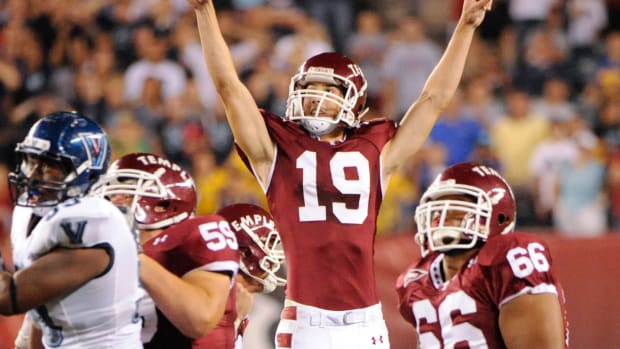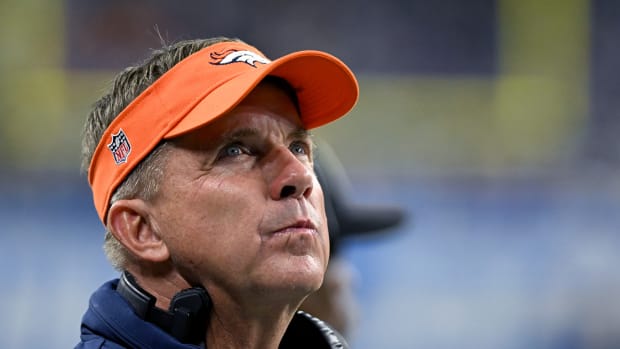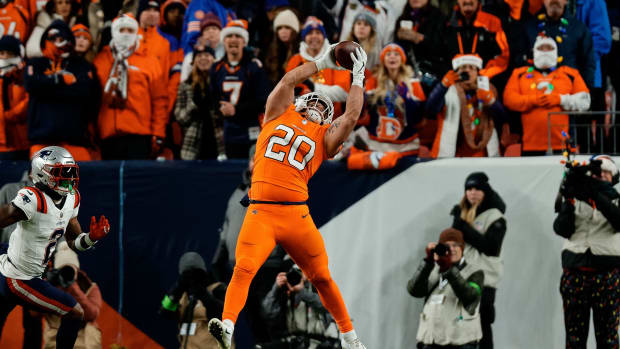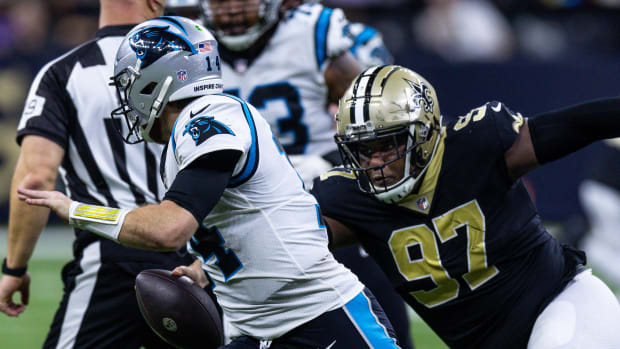Drew Lock's NFL Debut Produced a Concerning Advanced Metric
Drew Lock is undefeated as a starter in his career!
As Archie Manning told the Denver Broncos' rookie QB when he called to congratulate him following his debut win over the L.A. Chargers, “You can’t win them all if you don’t win your first.”
Of course, this was tongue-in-cheek given no quarterback will ever ‘win them all’, but a 23-20 victory over a very talented Chargers defense is about all anyone could have realistically hoped for. This was Lock’s first game as an NFL starter after all.
Lock certainly did not light up the stat sheet in his first start. This is not a shock given that many rookie quarterbacks have a fairly long developmental curve to climb before becoming entrenched starters and franchise-caliber players.
Many times teams will try to ‘protect’ their young quarterback, limit the play calls, make the progressions and reads as simple as possible, and not give him too much to handle, essentially putting training wheels on the bicycle that is the offense.
There is no doubt the Broncos and OC Rich Scangarello had the training wheels on for Lock on Sunday. Going 18-for-28 with a 64.3% completion percentage, 134 yards, two touchdowns, one interception, a quarterback rating of 84.5, and a QBR of 55.7. Lighting the world on fire? No.
But the flashes on tape were evident as were some of the concerns from his days playing at the University of Missouri. The sample size is small, no doubt, but it was as obvious on Sunday as it was on Draft Day, Lock has the tools to be a franchise quarterback in the NFL.
Does that guarantee that Lock will end up being the long-term answer for Denver? Absolutely not. There have been plenty of starting quarterbacks with incredible tools that didn’t pan out.
Work ethic and drive, injuries, and fatal flaws in mechanics, processing, and accuracy have doomed plenty of quarterbacks with similar size, athleticism, and arm talent. It takes more than tools, of course, but without those tools, the upside of that quarterback is somewhat limited in potential.
Sure, there are some concerns with Lock, particularly when it comes to his accuracy. His footwork, specifically when dropping back from under center, is still a work in progress which can make his ball placement a bit shoddy from pass-to-pass, especially when trying to deliver the ball further down the field.
Again, in regards to lower-body mechanics, Lock had a chance for a huge conversion on a roll-out where he didn’t square his feet before throwing, which caused the ball to sail on him. Fortunately, the errant throw fell harmlessly to the ground behind his target.
Lock's footwork does look improved since his college days (given a single-game sample size), but it remains something to monitor going forward nonetheless. As accuracy is directly correlated with lower body mechanics, it’s an area that must continue to be emphasized cleanly or his ball placement on any given throw could fail him and limit just how great he can become in the NFL.
With that said, Lock had plenty of highs on Sunday as well. He showed off the ad-lib ability he has, moving in the pocket, directing traffic, and finding tight end Jeff Heuerman in the middle of the field for a savvy third-down conversion.
Lock showed arm talent and touch on both his touchdown throws to Courtland Sutton (as well as the near touchdown to Noah Fant). Lock showed mobility to use his legs on bootlegs, to buy time, and to pick up yards when the defense let him.
As Lock stated on Wednesday, “You can’t go broke taking a profit.” This is absolutely true, and helps keep the offense moving in the right direction, but there is something to be said about the types of throws he made on Sunday.
A Concerning Advanced Metric
One thing of note coming out of Lock’s first start is just how low his Adjusted Net Yards per Pass Attempt ended up being. At just 4.61, Lock possesses one of the lowest ANY/A of any quarterback to start a game this season.
With only the likes of Brandon Allen (4.58), Ryan Finley (3.38), Brian Hoyer (3.21), Dwayne Haskins (2.68), Josh Rosen (2.15), Luke Falk (2.08), and Colt McCoy (1.00) possessing lower ANY/A than Lock having at least 15 attempts and starting a game this season, it is fair to question just how sustainable Lock's performance was on Sunday as such an outlier.
Before we dig too far into the ‘why’, it’s important to define ANY/A, what exactly is it? According to Inside the Pylon, ANY/A is: A passing statistic that incorporates passing yardage, sacks, touchdowns, and interceptions.
ANY/A is easy to calculate, easy to understand, and has a strong correlation with points scored. Like any passing metric, it is better used as a general measure of team or group passing effectiveness than as an individual statistic, as it does not control for quality of receivers, weather, offensive line, scheme, etc. It also does not incorporate quarterback rushing yards.
Like any per-play statistic, it can be inflated by long gains; success rate can paint a clearer picture of an offense’s consistency.
Bear with me as I explain what ANY/A’s formula is: (PASSING YARDS minus SACK YARDAGE plus (20 × TOUCHDOWNS) minus (45 × INTERCEPTIONS)) / (PASS ATTEMPTS + SACKS). This would make Lock’s ANY/A from Sunday:
134 Passing Yards minus 0 Sack Yards plus (20 x 2 touchdown) minus (45 x 1 interception) / 28 pass attempts plus 0 Sacks = 4.60714.
“But… I was told there would be no math... this is football!” Sorry, folks. The age of analytics in football is here and it's here to stay. Anything for the slightest competitive advantage.
Does ANY/A hold any water in determining whether a quarterback is ‘good’? The top-5 ANY/A quarterbacks in the league history are: Aaron Rodgers (7.35), Peyton Manning (7.17), Tom Brady (7.09), Russell Wilson (7.05), and Drew Brees/Tony Romo (7.03).
There is some recency bias in regards to how the league has changed in the current era of passing, but still the statistic tends to hold weight. To hammer this home, the worst ANY/A of any quarterbacks this season? Kyle Allen (4.86), Mason Rudolph (4.90), Daniel Jones (4.90), Mitchel Trubisky (5.13), Ryan Fitzpatrick (5.17), Andy Dalton (5.27), and Joe Flacco (5.29) — in comparison to Lock’s 4.60.
As was shown in the definition of the statistic, as is true for almost any football statistic, the team, coaching, and opponent plays a role. The Broncos have had issues at offensive tackle this season, mainly playing Garett Bolles and Elijah Wilkinson.
This would be a concern on any Sunday, but going up against the absolutely dominant duo of Joey Bosa and Melvin Ingram was always going to be a matchup that could change the outcome of the game and alter stats. The raw stats suggest the Broncos offensive line did great holding up against the Chargers pass rush, but make no mistake, game-plan and an overall conservative passing game called by Scangarello had a large part to do with blanking the Chargers from the sack column.
The Broncos also have a dearth of offensive play-makers. Outside of Sutton, who is playing at a top-5 in the NFL level, the Broncos have had to go through the high variance of an up-and-down rookie tight end in Fant, the disappointment of the non-Sutton WRs in DaeSean Hamilton and Tim Patrick, and just non-difference makers in the pass game at receiver or tight end.
Again, these deficiencies in personnel absolutely would have an impact on any quarterback's ANY/A, and this holds true for Lock on Sunday and the 2019 Broncos offense.
Furthermore, as has become the hot topic in Broncos Country following Lock being named the starter and the fanbase needing something new to get a bit riled up about, the conservative nature of Scangarello. After the first quarter's scripted plays in which the Broncos have moved the ball (and even scored!) at a very high clip, the offensive play calling falls off a cliff from the second to the fourth quarter.
The personnel, as indicated above, has a major role in these issues as the Broncos lack enough bonafide difference-makers on offense to really open things up, but Scangarello’s play-calling deserves scrutiny.
Lock is the one who has to make the reads and choose when and where to throw the football, but Scangarello and his play-calling struggles after the first quarter would be hampering any quarterback's ANY/A.
Perhaps you are a statistician, or anyone with a somewhat analytical brain and thinking to yourself, 'Okay, we get it that ANY/A is an interesting indicator of a passer’s success, but Hello?! 18 completions on 28 attempts in one game? Has anyone heard of sample size?! I mean how different would this be if Hamilton had caught that third down pass?'
You would be resoundingly correct. It is impossible to draw anything definitive from Lock’s first game statistics, let alone his first start as a professional quarterback. If anything, this should simply be an indicator that how the Broncos' victory on Sunday was an offensive anomaly and that Lock should regress towards the mean of league average after he plays the Houston Texans on Sunday.
What it Means
With each passing rep in practice, to each drop-back during a game, the Broncos will need to lengthen the leash for Lock. It is understandable trying to spoon-feed him to start, especially in the context of the issues the Broncos have on offense in personnel, but the ANY/A is a concerning statistic coming out of Lock’s first game.
Houston does not possess the pass-rushing prowess of the Chargers, and the Broncos will much more likely have to play keep-up rather than sit on a lead against DeShaun Watson and the Texans offense.
Does the single-game sample size of Lock’s ANY/A mean much? Probably not.
But it is a valuable tool in contextualizing his performance as a quarterback. Hopefully, the checkdowns decrease in nature, and Lock is able to hit more high-caliber throws at a higher rate as the season progresses.
The training wheels will likely remain on for the foreseeable future, but given the high rate of checkdowns and dump-offs this past Sunday, it's hard to imagine Lock and the offense being able to keep up and win games for the rest of the season playing like they did against the Chargers.
Hopefully, soon the Broncos can take those training wheels off and, in the least, be the parent holding the bike seat from behind as the child rides along and gains more confidence with just a bit more freedom. Sure, the kid might not be ready to ride the two wheels on the bike by himself, but just how can he progress with the training wheels on? Therein lies the rub.
Follow Nick on Twitter @NickKendellMHH and @MileHighHuddle.





